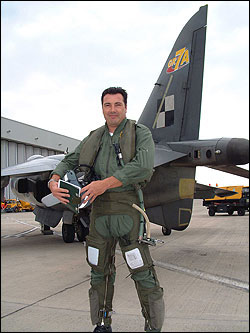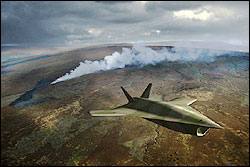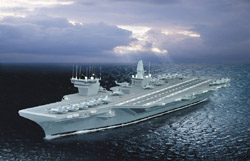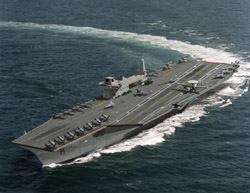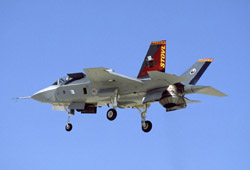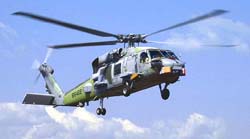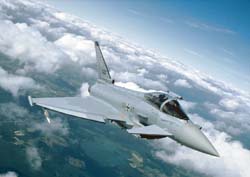Page 1
Daily News
By Gail Helmer
| Send Us News | Archives | Main |
Monday September 30, 2002
PC News
- Carl Norman Leaves Ubi Soft
- Airborne Assault Patch 2 with MapMaker
- Forgotten Battles Development Update
- New Screens: Lock On Modern Air Combat
- Saudia Arabia to purchase Typhoon
- Harrier GR7A Makes First Flight
- BAE Systems Awarded FOAS C4ISTAR Contract
- UK MOD Announcement On F-35 JSF And Future Carrier
- Testing Milestone for MH-60R Helicopter
- DASS Testing For Eurofighter Typhoon Successful
Carl Norman Leaves Ubi Soft
Ubi Soft announced today that Carl Norman has left the company to pursue other career opportunities.
"Carl is a tremendous asset to the simulation community and he will be sorely missed in the halls of Ubi Soft, San Francisco. Over the years, Carl has been a tireless advocate of the simulation titles we love so much, and he has always fought to better the genre. I hope that Carl will continue to work in the industry and help us (as a whole) make better games," said Matt Wagner, Producer, Ubi Soft.
On behalf of everyone at COMBATSIM.COM we wish Carl the best of luck in his future endeavors.
Click here to read Carl's farewell speech.
Airborne Assault Patch 2 with MapMaker
Battlefront.com has released Patch 2 for Airborne Assault - Red Devils over Arnhem. This patch includes the new beta MapMaker application. With the MapMaker and the previously released ScenMaker, users now have complete freedom to design their own battles for the AA engine, including non-Market Garden battles covering the actions on the entire Western Front 1944-1945. Also released in conjunction with Patch 2 and available for separate download are three AA Expansion Packs, each containing a map with one or more scenarios:Click here. to download the free patch and expansion packs.
- Nijmegen Crossing – 8 x 8km map based on the bridges across the Waal River at Nijmegen. Comes with one non-historical scenario.
- Singling – 12 x 15km map based on a section of the Saar River area in eastern France 1944. Comes with three non-historical scenarios.
- Panther Lair – 10 x 10km fictional map. Comes with one non-historical scenario.
Forgotten Battles Development Update
Check out the latest screenshots from the upcoming IL-2 Sturmovik add-on, Forgotten Battles. The screens include, a new online map in the mountains, Shots of the new water and focus on the TB-3.
New Screens: Lock On Modern Air Combat
We have the new screens from Ubi Soft's work-in-progress development shots of Lock On: Modern Air Combat. This week we have an example of cockpit lighting and a shot showing the new aircraft shelters, and four new Lock On interface screens.
Military News
Saudia Arabia to purchase Typhoon
A story in the UK newspaper, The Observer reports that BAE Systems may be progressing talks with Saudia Arabia to purchase the Eurofighter Typhoon. The report (resulting in a rise in the BAES share price) suggests a 50 fighter deal is being discussed worth around £1.5B. According to the report the deal may mirror the al-Yamamah oil for arms arrangement of the 80's which saw Saudi purchase Tornado and other equipment.
Harrier GR7A Makes First Flight
A more powerful version of the GR7 Harrier has made its first flight. The development GR7A took off from Warton in Lancashire at 16.32 on Friday September 20 and landed after a 45-minute flight.
Test pilot Mark Bowman after the successful Harrier GR7A first flight on Friday.
Test pilot Mark Bowman said: "During today's flight the new Pegasus 107 engine behaved fully as expected across the flight envelope, which included a close look at the much improved hover performance. This additional performance represents a significant increase in the overall operational capability of the Harrier and forms a cornerstone element of the advanced Harrier GR9A programme."
The GR7A is development of the GR7 currently in service with the RAF and selected for Joint Force Harrier. It features an uprated, lower-maintenance Rolls-Royce Pegasus engine which develops an extra 3,000 lbs thrust above 30 degrees centigrade. The extra power allows the all-up weight of the aircraft to be increased from 32,000 to 34,000lbs, improves performance (including weapons 'bring back'), particularly under hot conditions such as the Gulf where there can be a marked decline in the aircraft's hovering performance.
The MOD initiated the engine upgrade in December 1999, contracting Rolls-Royce to remanufacture 40 Pegasus Mk 105 engines to the Mk107 standard. BAE SYSTEMS Customer Solutions & Support business will supply modification kits to enable 40 aircraft to take the new engines. (The running fleet of operational aircraft is expected to be 30 aircraft in three squadrons.) The combined activity is worth £150m and the first 20 aircraft will be completed by April 2004. The balance will be completed through the GR9 programme.
BAE Systems Awarded FOAS C4ISTAR Contract
BAE SYSTEMS has been awarded one of two £700,000 contracts by the UK's Defence Procurement Agency (DPA) to develop the definition of the Command, Control, Communications, Computers, Information/Intelligence, Surveillance, Targeting Acquisition and Reconnaissance (C4ISTAR) architecture for the Future Offensive Air System (FOAS) programme.
Artist concept of the Future Offensive Air System.
FOAS will supply the UK with a significantly expanded long-range offensive air capability to replace that currently provided by the Tornado GR4. The programme is addressing a number of current and future platforms, weapon systems and capabilities that need to be harnessed and integrated into the wider battlespace, in order to achieve best results. This study will understand and analyse the role that C4ISTAR systems and architectures will contribute to enabling a Network Enabled Capability approach to satisfying the FOAS requirements.
Recognising the breadth of skills required to deliver integrated C4ISTAR architectures, BAE SYSTEMS has formed a broad-based team focused on delivering the study requirements and capable of implementing solutions in the longer term.
The FOAS Team within Air Systems New Business group will work collaboratively with the C4ISR Business Unit within BAE SYSTEMS, who will lead and discharge this element of the FOAS activity. This has been an early opportunity for the Air Systems and C4ISR Business Units to demonstrate the potential of an integrated approach in the field of C4I and ISTAR that will be required to ensure a successful programme.
UK MOD Announcement On F-35 JSF And Future Carrier
The Defence Procurement Minister, Lord Bach, announced on 30 September 2002 the selection of the short take-off and vertical landing (STOVL) variant of the Lockheed Martin F-35 Joint Strike Fighter to equip the Royal Navy's new aircraft carriers. The carriers will, however, be designed to allow future adaptation to accommodate other aircraft designs if need be.
Thales' concept for the future carrier
BAE Systems' design
The STOVL variant of the F-35 Joint Strike Fighter
The STOVL version of the F-35 meets the UK's requirement for a Joint Combat Aircraft to replace the Harrier, both for service afloat and ashore, retaining the flexibility offered by a "jump-jet" configuration, yet offering all the advantages of a modern stealth design. This version is alo being adopted by the US Marine Corps. However, given that the new carriers are planned to have a service life of up to fifty years - longer than that expected for the aircraft - BAe Systems and Thales, competing for the design and construction of the vessels, have been asked to opt for a design which can be adapted to operate more conventional aircraft types if necessary later in the ships' lives. To this end, the ships will have the capability to be fitted with catapults and arrestor gear, although they will be built with the "ski-ramp" well-known from the Royal Navy's current Invincible class carriers for STOVL operations.
The UK is heavily involved in the Joint Strike Fighter project, with Rolls-Royce leading the development of the lift system for the STOVL variant.
Testing Milestone for MH-60R Helicopter
Lockheed Martin has successfully completed the second of four major testing milestones required prior to the U. S. Navy's MH-60R Multi-Mission helicopter entering Operational Evaluation in 2004. The joint Lockheed Martin/ Navy test team for the MH-60R completed the critical mission test known as Development Testing Phase IIC (DT IIC), two days ahead of schedule, moving the program closer to fleet introduction in late 2005.
The combined test team, consisting of U.S. Navy pilots, engineers and aircrew and Lockheed Martin, completed 151 test flights, 494 flight hours and 1,540 ground hours on two prototype MH-60R aircraft from July 2001 to July 2002. The testing was conducted at the Naval Air Station and the Air Combat Environmental Test and Evaluation Facility (ACETEF), both in Patuxent River, MD.
The main focus of the DT IIC test was to test critical naval at-sea mission systems, especially the Multi-Mode Radar (MMR), Electronic Support Measures (ESM) and Identification Friend or Foe (IFF) interrogator. The multiple modes of the MMR were of special interest during this phase, with evaluations conducted on the periscope detect mode, short/long range search, target designate and the Inverse Synthetic Aperture Radar mode.
In addition to these primary test events, DT IIC provided data flights on acoustics, data link and mission scenarios testing. During these tests, the AQS-22 Airborne Low Frequency Dipping Sonar was exercised in deep and shallow water acoustic flights. The Anti-Submarine Warfare/Anti-Surface Warfare non-acoustic 2005 mission scenarios also were flown. ESM, IFF and radar information was data linked from the MH-60R aircraft to the ship ground station.
DASS Testing For Eurofighter Typhoon Successful
Flight trials of the Typhoon's Defensive Aids Sub-System (DASS) have shown that the system is delivering performance that meets or exceeds expectations. Recent trials, covering the air-to-air and air-to-ground operation of the Electronic Support Measures (ESM) and Electronic Countermeasures (ECM), have been conducted on a Typhoon operating from the BAE SYSTEMS facility at Warton in north west England.
This series of flight trials has been aimed at data collection, to optimise the performance of the final production-standard equipment.
DASS - the Defensive Aids Sub-System for Typhoon - is a fully integrated Electronic Warfare (EW) suite with a Radar Warning Receiver (RWR), RF Jammer, radar decoys, active missile approach warner, laser warner and chaff/flare dispenser. All are controlled through the Defensive Aids Computer.
[ Send Us News | Archives ]
Click Here for Printer Version
| Send Us News | Archives | Main |
